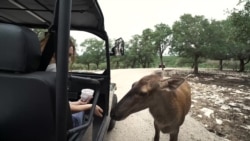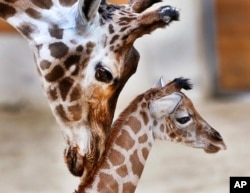Imagine a world with no more wild animals: no elephants, no giraffes or lions.
To some people, that thought is too terrible for words. So, they are doing something about it.
Being surrounded by wild animals -- feeding them and caring for them -- is all Tiffany Soechting has wanted to do with her life.
And that is exactly what she does!
Soechting is the human "mother" to the 500 animals that live on her family's wildlife farm in San Antonio, Texas.
At Natural Bridge Wildlife Ranch, she cares for creatures from around the world. They come from every continent except Antarctica.
“The only continent that we do not have represented is Antarctica. We were very blessed that we do not have any animals that we imported from their homeland.”
Soechting says she loves them all. However, she admits that the giraffes occupy a special place in her heart. Buddy the giraffe lives at the wildlife ranch.
Buddy had a twin sister named Wasswa, who died a few years ago. They were one of nine living sets of twin giraffes born in the past 200 years. After getting some media attention, Soechting helped co-found a wildlife group called Save The Giraffes.
Buddy belongs to a sub-group of giraffes known as reticulated giraffes. The animals are native to East Africa. Tiffany Soechting says wildlife experts are concerned about their shrinking numbers.
“And reticulated giraffes … their population in the last 15 years has declined by 80 percent. I was very blessed that I made connections with five of those researchers that took the giraffes up to level that they are classified as vulnerable.”
Here, Soechting is talking about organizations that follow the condition of animal populations and rate their standing in the wild. On this rating scale, “vulnerable” is worse than “near threatened” but better than “endangered.”
One such organization is the International Union for Conservation of Nature (IUCN), which publishes a Red List of Threatened Species. The IUCN claims that currently 26,500 animal species are at risk of disappearing forever. So, it is good news when an animal is removed from the endangered list. That is what happened with reticulated giraffes.
Over 500 animals -- including some endangered species -- live there at the wildlife ranch. Visitors get a chance not just to see these creatures, but also to feed them. And the animals are not against that. For them, people and special vehicles used on the ranch are part of their natural environment.
“When you come here, the animals are roaming freely like they would if they were in their native homeland. And you can touch (th)em. And I think it makes that connection and that animal being endangered more important to every person.”
Soechting explains that most of the animals were born and raised on the ranch.
"For the most part, the majority of (th)em were born and grew up here. But even when we bring them in -- like if we bring a new male in -- the whole rest of the herd is comfortable with what is going on.”
Living on the ranch is a scimitar-horned oryx -- an animal that Soechting told VOA is no longer found in the wild.
"These are scimitar-horned oryxs. Totally extinct in the wild. There are none left. Here on the ranch we have over 60. Their breeding program has been very successful. Very proud of that."
Tourists are not the only people to visit Natural Bridge Wildlife Ranch. Many schools come for field trips all throughout the year. So, it is a place of education as well as conservation.
But for Soechting, the ranch is simply home. And it has been for many generations.
"My husband is the fifth generation. We raised both of our boys on the ranch. Now my oldest son had a son – just last night. So, now that will be the seventh generation lives on the Wildlife Ranch as well.”
As the animals walk peacefully around the grounds, it is easy to forget that San Antonio, a busy city, is just a few minutes away. Tiffany Soechting and the 500 animals do not seem to give it a second thought.
I’m Anna Matteo.
Anush Avetisyan reported this story for VOA News. Anna Matteo adapted the report for Learning English. George Grow was the editor.
Editor's Note: The original story contained incorrect information on Buddy and Wasswa and the organization co-founded by Soechting. We regretted the errors.
______________________________________________________________
Words in This Story
ranch – n. a large farm especially in the U.S. where animals (such as cattle, horses, and sheep) are raised
twin – n. either one of two babies that are born at the same time to the same mother
zoo – n. a place where many kinds of animals are kept so that people can see them
decline – v. to become lower in amount or less in number
blessed – adj. bringing pleasure, contentment, or good fortune
vulnerable – adj. open to attack, harm, or damage
conservation – n. a careful preservation and protection of something
comfortable – adj. not having any physically unpleasant feelings : experiencing physical comfort : allowing you to be relaxed : causing no worries, difficulty, or uncertainty









